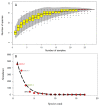A Diverse Virome of Leafroll-Infected Grapevine Unveiled by dsRNA Sequencing
- PMID: 33050079
- PMCID: PMC7599845
- DOI: 10.3390/v12101142
A Diverse Virome of Leafroll-Infected Grapevine Unveiled by dsRNA Sequencing
Abstract
Quebec is the third-largest wine grape producing province in Canada, and the industry is constantly expanding. Traditionally, 90% of the grapevine cultivars grown in Quebec were winter hardy and largely dominated by interspecific hybrid Vitis sp. cultivars. Over the years, the winter protection techniques adopted by growers and climate changes have offered an opportunity to establish V. vinifera L. cultivars (e.g., Pinot noir). We characterized the virome of leafroll-infected interspecific hybrid cultivar and compared it to the virome of V. vinifera cultivar to support and facilitate the transition of the industry. A dsRNA sequencing method was used to sequence symptomatic and asymptomatic grapevine leaves of different cultivars. The results suggested a complex virome in terms of composition, abundance, richness, and phylogenetic diversity. Three viruses, grapevine Rupestris stem pitting-associated virus, grapevine leafroll-associated virus (GLRaV) 3 and 2 and hop stunt viroid (HSVd) largely dominated the virome. However, their presence and abundance varied among grapevine cultivars. The symptomless grapevine cultivar Vidal was frequently infected by multiple virus and viroid species and different strains of the same virus, including GLRaV-3 and 2. Our data show that viruses and viroids associated with the highest number of grapevines expressing symptoms included HSVd, GLRaV-3 and GLRaV-2, in gradient order. However, co-occurrence analysis revealed that the presence of GLRaV species was randomly associated with the development of virus-like symptoms. These findings and their implications for grapevine leafroll disease management are discussed.
Keywords: Vitis vinifera; dsRNA extraction; grapevine leafroll disease; interspecific hybrid; viromics; virus co-occurrence; virus epidemiology.
Conflict of interest statement
The authors declare that we have no known competing financial interest or personal relationships that could have appeared to influence the work reported in this paper.
Figures








References
-
- Statistic Canada Table 32-10-0364-01 Area, Production and Farm Gate Value of Marketed Fruits. [(accessed on 17 June 2020)]; doi: 10.25318/3210036401-eng. Available online: - DOI
-
- Martelli G.P. Directory of virus and virus-like diseases of the grapevine and their agents. J. Plant Pathol. 2014;96:1–136.
-
- Fuchs M. Grapevine viruses: A multitude of diverse species with simple but overall poorly adopted management solutions in the vineyard. J. Plant Pathol. 2020;102:643–653. doi: 10.1007/s42161-020-00579-2. - DOI
-
- Alabi O.J., Casassa L.F., Gutha L.R., Larsen R.C., Henick-Kling T., Harbertson J.F., Naidu R.A. Impacts of Grapevine Leafroll Disease on Fruit Yield and Grape and Wine Chemistry in a Wine Grape (Vitis vinifera L.) Cultivar. PLoS ONE. 2016;11:e0149666. doi: 10.1371/journal.pone.0149666. - DOI - PMC - PubMed
-
- Atallah S.S., Gomez M.I., Fuchs M.F., Martinson T.E. Economic Impact of Grapevine Leafroll Disease on Vitis vinifera cv. Cabernet franc in Finger Lakes Vineyards of New York. Am. J. Enol. Vitic. 2012;63:73–79. doi: 10.5344/ajev.2011.11055. - DOI
Publication types
MeSH terms
Substances
Supplementary concepts
LinkOut - more resources
Full Text Sources

